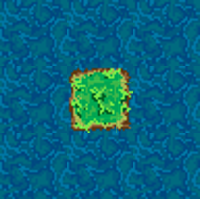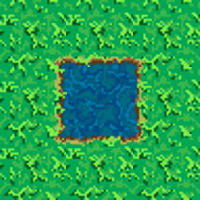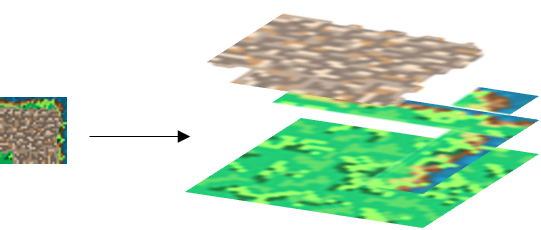A free-to-use, dynamic tileset.

Designed by David Gwizdala, licensed under a Creative Commons Attribution 4.0 International License.
Table of Contents
Tiles
Tiles consist of 32x32 pixel, non-rotatable squares. Tiles have a base terrain type, used as the base layer in procedurally generating the map, and border types, overlayed over the base terrain type to allow for smoother transition between different terrain.
Base Terrain Types
The current terrain types are:
- Water

- Grass

- Sand

- Snow

To access the base terrain tile of any terrain type, navigate to the directory with that item’s name and reference spr_[terrain_type]_center.png, where [terrain_type] is the type of terrain. On every tile, the base terrain type will be referenced in the name, with the subdirectory detailing border (detailed below).
For example, the base terrain type of water is located at the path ./Water/spr_water_center.png.
Border Types
All borders between tiles are unique, and follow a strict set of rules on how to overlay them.
Border Overlay
All border types consist of 12 32x32 pixel overlay tiles. Their names consist of a base naming convention, used to define their exact location on the border, and of a corner naming convention, used specifically on tiles bordering on a corner (more details below).
Base Naming Convention
The base naming convention is as follows:

For example, any tile bordering the left side of grass will be referenced in their appropriate subdirectory as spr_grass_left.png.
Corner Naming Convention
The corner naming convention applies only to corners, as there are two possible cases for tile cornering.
Note: When building borders, always place the non-corner borders (top, bottom, left, right) first as they may be overlayed with a corner tile.
Firstly, there is the case of the base tile extending into the border tile, such as an island in the water. Think of this as an extruded corner. This is considered an outer corner, designated with the outer tag. The outer corner requires the use of side borders. Note: The tile overlay is still on the base tile, which means that the corner does not literally extend into the border tile - it simply creates the guise of doing so.

For example, any tile creating an outer corner on the top left side of grass will be referenced in their appropriate subdirectory as spr_grass_outer_tl.png.
Secondly, there is the case of the border tile extending into the base tile, such as a lake or a pond. Think of this as a recessed corner. This is considered an inner corner, designated with the inner tag. The inner corner does not require the use of side borders.

For example, any tile creating an inner corner on the top left side of grass will be referenced in their appropriate subdirectory as spr_grass_inner_tl.png.
A diagram detailing corner naming is shown below.

To summarize, when placing border types place the non-corner tiles first, and then determine whether the corner tiles protrude or recede from the bordering tile.
Terrain Hierarchy
Terrain borders follow a Terrain Hierarchy, defined as shown:
Snow ⮧
Sand ⮧
Grass ⮧
Water
In the hierarchy, tiles provide border types only for the tiles below it, with no knowledge of the tiles above. This aims to follow standard blending of real-life terrain. It is recommended to consider the lowest tile the base case, as it does not follow any rules for bordering.
For example, the tile highest on the hierarchy, Snow, provides border tiles for all types, while Sand provides border tiles for Grass and Water, Grass provides border tiles for Water, and Water does not provide border tiles at all.
To access the border tiles of any terrain type, navigate to the directory with the base item’s name and the subdirectory with the border item’s name and reference spr_[terrain_type]_[border].png, where [terrain_type] is the base terrain type and [border] is the side/corner that you are bordering.
For example, to overlay a border tile of water on the left side of grass you would navigate to the path ./grass/water/spr_grass_left.png.
Sample Algorithm for Terrain Placement
Here is a sample description of an algorithm for terrain placement in a grid:
for each piece of terrain T:
let BORDERS = the terrain adjacent to T
for each BORDER in BORDERS:
if T is below BORDER in the hierarchy then
layer the corresponding border tile on top of T
let CORNERS = the terrain diagonal to T
for each CORNER in CORNERS:
if T is below CORNER in the hierarchy then
let adj1 and adj2 = the two pieces of terrain bordering both T and CORNER (so if CORNER
is the top right diagonal, then adj1 and adj2 are the terrain above and to the right of T)
if adj1 and adj2 are both below CORNER in the hierarchy:
then CORNER is "flooding over" adj1 and adj2, and thus should be flooding over the
corner of T, so place an "outer" corner tile on top of T
else if adj1 and adj2 are both above T in the hierarchy:
then T is being "flooded over" by adj1 and adj2 so:
if adj1 and adj2 are the same type of terrain:
place an "inner" corner tile of that type on T
else
figure out if adj1 or adj2 is lower in the hierarchy, and make sure the border
for that terrain is placed on top of the other one on T
Layering Schema
To draw the entire scene on a grid square, follow the below diagram for best visual results.

To better illustrate this schema, an example is shown below where a grass square corners water and contains a road.

